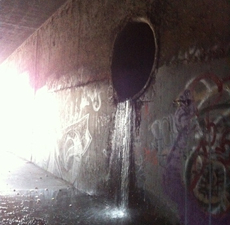


Urban Water Environment (UWE) is about cities where, worldwide, human populations are concentrated. Cities employ, house, sustain, entertain, educate, and transport people. In cities, there are no real boundaries between “natural” and built environments: yards and parks surround residences, manufacturing plants, and offices; these are bridged by hardscaping, and buried infrastructure. Potable water—the foundation of U.S. cities—is continuously delivered for consumption and irrigation; the byproducts are sewage and stormwater runoff, whose management profoundly affects the urban lifeblood, i.e. the resupply of healthful, potable water. This system of urban water is, however, increasingly challenged by higher water demands from larger urban populations, more complex wastewater composition, aged infrastructure, more land development, soil contamination, and a changing climate.
Research has informed urban water quality management, although the endeavors are often piecemeal, i.e. addressing either water provision, sewage, stormwater runoff, or specific contaminants. Research would ideally be integrated and prioritized around a central vision for comprehensive water quality management, where individual projects inform management of a whole system. UWE is a research program oriented to inform management for improved urban water quality. To advance, knowledge and approaches are recruited from relevant disciplines, including engineering, chemistry, soil science, microbiology, ecology, hydrology, and information management. The research questions include:
- What are the fates of contaminants released from aged wastewater infrastructure (i.e. gravity or pressurized sewers), including transport and transformation in nearby (including beneath pavement) soils, drains, and surface waters? The impacts of answering include improving infrastructure design criteria, guiding restoration, and identifying priorities for controlling chemical and pathogen pollution.
- What soil conditions promote multiple pollutant attenuation, and what mathematical models best describe the processes in space, and in time? The impacts of answering include predicting contaminant migration, and allowing for managing the reactive soil environment to prevent groundwater contamination by chemicals and pathogens from sewage or stormwater runoff.
- What are the characteristics of nutrient cycling in urban open spaces, including soils, water, and sediments associated with natural treatment systems (NTS), and how are the processes affected by pollution (e.g. metals, pesticides, hydrocarbons, engineered nanomaterials, and other micropollutants)? The impacts of answering include predicting pollution generation (e.g. nitrate, and greenhouse gases of N) and attenuation (e.g. denitrification) patterns within urban environments, and thus how to promote ecosystem functions for improved water quality while minimizing undesired secondary processes.
- How can geographic information systems be used to prioritize research and management of the urban water environment? The impacts of answering include revealing how multiple information sets (e.g. physical attributes, and monitoring data) can be structured and continuously refreshed to reflect current conditions.
How does urbanization affect the urban water environment? Answering requires analyzing relevant data across space and time to reveal how cities affect the urban water environment, with a goal of informing actions to improve and protect urban water quality.
UWE was launched through the generous support of Mr. Henry (Sam) Wheeler, and continues via various government funding sources.
updated 12-31-19

